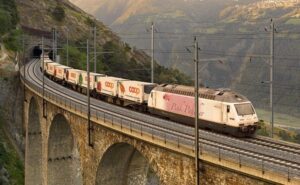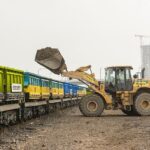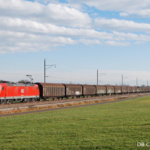The Coop Group has committed itself to reducing CO2 emissions. Shifting transport to rail is a central component of this strategy. In an interview with VAP, Daniel Hintermann, Head of Logistics at the Coop Group, explains how the retail and wholesale group is achieving this and the challenges it faces.
VAP: Mr Hintermann, how did the Coop Group manage to shift two thirds of the transport between its distribution centres to rail?
Daniel Hintermann: It was a process that took several years. It was initiated in 2010 with the decision to buy a freight railway. At that time, we took over Railcare AG as a wholly owned subsidiary. We gradually integrated the small rail transport company into Coop’s logistics world. Today, Railcare is an integral part of our Group-wide transport chain. It enables us to further increase the proportion of rail transport.
How did the Coop Group come to have its own rail transport company?
In 2008, Coop developed its vision for CO2 neutrality and the centralisation strategy for logistics and production. We were looking for new approaches to transport logistics in order to achieve the goals we had set ourselves. We found what we were looking for with the Railcare concept at the time.
What proportion of rail transport are you aiming for?
We can imagine increasing the share of rail transport in Swiss delivery traffic – i.e. the outbound business – from 40% today to 50%. We see similar potential for inbound traffic from Europe and Switzerland. To achieve these goals, we are facing a challenging relocation process lasting several years.
What advice would you give to other companies that want to shift transport from road to rail?
In my opinion, the top management team needs to be determined to actively shift transport. This requires a high degree of standardisation in the equipment and close process networking between the shipper and the railway.
How does the Coop Group co-operate with the VAP?
Coop has been a member of the VAP for many years. We have repeatedly been able to count on the professional support of the VAP, particularly for contracts, project support or technical recommendations on the subject of sidings.
What strengths do you attribute to the VAP?
The VAP is particularly strong when it comes to knowledge about sensible contracts and applicable regulations. We appreciate the fact that the people in charge are available at any time and in an uncomplicated manner, take a pragmatic approach and offer practical and realisable solutions.
How would you describe the VAP?
As a central knowledge platform for all aspects of rail freight transport for the Coop Group as a shipper.
Who would you recommend working with the VAP?
All shippers who transport goods by rail or want to do so in the future.
Where do you see the most urgent need for action in rail freight transport?
Digitalisation across the entire transport chain. There is also an urgent need for automation on the last mile and in shunting traffic.
What would you like to see for the future of rail freight transport in Switzerland?
I would like to see rail freight transport become sustainably competitive. To achieve this, it must make sufficient train paths available to the rail freight companies. Finally, I would like to see more dynamism in process changes, for example when it comes to changing transport flows.
What has not yet been said?
We are seeing a trend towards over-regulation and technocracy in rail freight transport. This makes rail freight transport neither safer nor more competitive. The players involved should join forces to counteract this development.
Thank you, Mr Hintermann, for the informative interview.

Daniel Hintermann has been Head of Logistics and a member of the Coop Group’s Executive Board since 2017. His long career at Coop began in 2001 at Interdiscount, and in 2010 he became Head of Logistics Region Northwestern Switzerland. The licensed business economist gained his first professional experience in management consultancy.

The Coop Group is the largest retail and wholesale company in Switzerland. It employs 94,790 people – including 3,417 apprentices – and operates 2,633 sales outlets/markets in Switzerland and Europe. One pillar is the retail trade with the Coop supermarkets and numerous specialised formats in Switzerland, the second is international wholesale and production.



